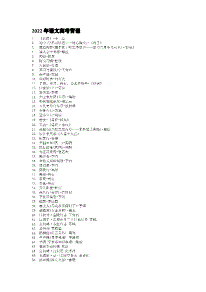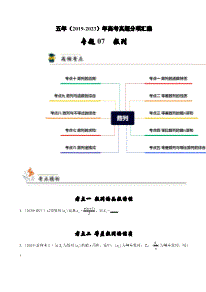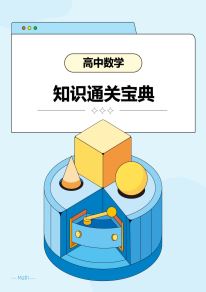(Part One)
1
目 录
一、动词 .............................................................................................................................................................. 3
易错点 1:一般过去时态 ................................................................................................................................. 3
易错点 2:现在完成时态 ................................................................................................................................. 5
易错点 3:过去完成时态 ................................................................................................................................. 6
易错点 4:被动语态 ......................................................................................................................................... 7
易错点 5:情态动词 ......................................................................................................................................... 8
易错点 6:系动词 ............................................................................................................................................. 9
易错点 7:谓语与非谓语 ............................................................................................................................... 10
二、名词 ............................................................................................................................................................ 12
易错点 8:名词单复数形式误判 ................................................................................................................... 12
易错点 9:专有名词 ....................................................................................................................................... 14
易错点 10:名词所有格................................................................................................................................. 14
易错点 11:名词辨析..................................................................................................................................... 15
三、形容词&副词........................................................................................................................................ 17
易错点 12:形容词比较级最高级 ................................................................................................................. 17
易错点 13:形容词副词辨析......................................................................................................................... 18
四、代词 ............................................................................................................................................................ 21
易错点 14:物主代词..................................................................................................................................... 21
易错点 15:反身代词..................................................................................................................................... 21
易错点 16:不定代词..................................................................................................................................... 22
五、数词 ............................................................................................................................................................ 26
易错点 17:数词误用..................................................................................................................................... 27
2
一、动词
易错点 1:一般过去时态
谓语:did
时间状语:yesterday, last month, last year, at that time, just now, the other day, two days ago, in 2019
用法:
1)表示过去某一段时间所发生的动作或存在的状态。
The live basketball match was broadcast last night.
2)表示过去经常、反复发生的动作。
His mother got up early as usual.
易错不规则变化动词:
动词原形 过去式 过去分词 词义
burn burnt burnt 燃烧
deal dealt dealt 解决;处理;分配
hang hung hung 绞死,悬挂
light lit lit 点燃, 照亮
send sent sent 送
dig dug dug 挖掘
feed fed fed 喂养;饲养
flee fled fled 逃避;逃跑
find found found 发现,找到
hold held held 拥有;把握
lead led led 引导;领导
stick stuck stuck 刺入;粘住
strike struck struck 撞击;冲击;罢工
sweep swept swept 扫
weep wept wept 哭泣;流泪
lay laid laid 下蛋, 放置
blow blew blown 吹风;喘气;叫
drive drove driven 驾驶
draw drew drawn 画画;拖拽
fall fell fallen 落下;跌倒
forbid forbade forbidden 禁止;不许
give gave given 给;提供;授予
3
grow grew grown 生长;种植
know knew known 知道
overeat overate overeaten (使)吃过量
prove proved proven 证明, 试验
throw threw thrown 抛,扔,掷
ride rode ridden 骑;乘车
shake shook shaken 摇动;震动
choose chose chosen 选择
hide hid hidden 隐藏
forget forgot forgotten 忘记;忽略
freeze froze frozen 冷冻;结冰
steal stole stolen 偷窃;窃取;偷盗
begin began begun 开始
drink drank drunk 喝
sing sang sung 唱
sink sank sunk 下沉, 沉没
swim swam swum 游泳
ring rang rung 戒指;环围
bear bore born 负担, 忍受
fly flew flown 飞行
lie lay(lied) lain(lied) 躺;位于(说谎)
wear wore worn 穿
bite bit bitten 咬;刺痛
tear tore torn 流泪;撕破;猛冲
【经典例题】
Picking up her “Lifetime Achievement” award, proud Irene ________ (declare) she had no plans to retire from her
36-year-old business.
【易错分析】
本句的难点在于句中没有明确的时间状语,根据后半句 he had no plans to retire from her 36-year-old
business 可得知动作发生在过去,动作在过去开始在过去结束,且对现在没有影响,使用一般过去时态,
答案填 declared。
【经典例题】
The unmanned Chang’e-4 probe --the name was inspired by an ancient Chinese moon goddess-- ________
(touch) down last week in the South Pole-Aitken basin.
4
【易错分析】
通过时间状语 last week 可以判断出动作发生在过去,且原句没有谓语动词,所以填写动词 touched,
本句容易误认为是非谓语动词,导致理解出错。动词题解题第一步需要判断句子的完整性,然后结合时间
状语和句意综合判断,得出答案。
易错点 2:现在完成时态
谓语:have/has done
时间状语:since+时间点,for+时间段,recently,so far, by now, up to now, in/during/over the past/last few
days ,already, yet, lately, never, ever, before, since, then 等
用法:
1)动作发生在过去,对现在造成影响或结果。
The friendly relations and cooperation between our two states have been enhanced in the past few years.
2)动作从过去某时开始延续至今的动作和状态。这时只能用延续性动词,
常与 for, since 等引导的时间状语连用。
I have travelled to most of the cities in America since five years ago.
3)在时间状语从句和条件状语从句中,用现在完成时代替将来完成时。
You shouldn’t leave school before you’ve finished your assignment.
4)用于固定句型中,如:
This is the first/second/…time that…(这是….第一/二/…次…….)
It has been+时间段+since 从句 (从句常用一般过去时)
现在完成 VS 一般过去
一般过去时仅指动作在过去发生了,对现在没有影响。
现在完成时的动作虽然发生在过去,但对现在有影响。
【经典例题】
The number of medical schools reached 18 in the early 1990s and ________ around that level ever since.
A. are remaining B. have remained
C. is remaining D. has remained
【易错分析】
句意:20 世纪 90 年代初,医学院的数量达到了 18 所,此后一直保持在这个水平。根据时间状语 ever
5
since 可知,此处应用现在完成时。句子主语为 The number of medical schools,为单数名词,谓语动词应用
单数形式,故选 D。对现在完成时态的时间状语不够熟悉容易导致解题出错。ever since, so far,
during/in/over/for the past/last+时间段和 recently 等时间状语均是现在完成时的标志词。
易错点 3:过去完成时态
谓语:had done
时间状语:常与过去完成时连用的时间状语:
by the end of last week, by that time, before that year, before I arrived
用法:
1)表示在过去某一时刻或动作之前已完成的动作,即“过去的过去”。
By the end of yesterday, we had received over 100 letters from all over the world.
2)表示动作从过去某一时间开始,一直延续到过去另一时间的动作,常用时间状语有 by/until/before/by the
end of+表过去的某一时间。
I closed the window before I left the room.
3)固定结构:
That/It was the first/second/…time+ that 从句(从句用过去完成时)
It was/had been+时间段+since 从句中(从句用过去完成时)
hardly + had sb done (过去完成时态半倒装)+ when… done(一般过去时)…. 一…就
no sooner + had sb done(过去完成时态半倒装) +when….done(一般过去时) 刚….就
Hardly had his sister heard the terrible news when she burst into tears.
【经典例题】
In the 1950s in the USA,most families had just one phone at home,and wireless phones _______ yet.
A. haven’t invented B. haven’t been invented
C. hadn’t invented D. hadn’t been invented
【易错分析】
句意:二十世纪五十年代在美国,绝大多数家庭只有一部电话,无线电话还没有发明出来。句中 invent
与主语 phones 构成动宾关系,要用被动语态;invent 的动作发生在谓语动词 had 之前,是过去的过去,要
用过去完成时态的被动语态。故选 D。
6
易错点 4:被动语态
英语的被动语态体现在动词的变化上。一般说来,只有及物动词能用于被动语态,常见不用于被动语态的
动词(短语)有:
1)1.不及物动词(短语),如 happen,occur, take place, break out 等
2.归属类动词(短语),如 belong to, have, own
3.last,look like 等动词短语表示状态或情况,不表示动作时,不用于被动语态
4.系动词,如 appear, seem, become, keep
2)不带 to 的不定式作宾语补足语在变为被动时要加上 to
常见动词有 make, let, have, hear, watch, see, feel, notice, help
主动:I heard her move about in her room upstairs last night.
被动:She was heard to move about in her room upstairs last night.
3)主动形式表示被动意义
sth want(s), need(s), require(s)+doing 表示某事需要被做
sth be worth doing 表示某事值得被做
The flower want watering.
感官动词主语是物时:sound, taste, smell, feel, look
The ice-cream tastes good.
一些不及物动词,表示主语本身所具有的性能时。
常见动词有:open, close, shut, read, write, wash, wear, sell.
The shoes wears comfortably.
【经典例题】
We live in a beautiful cottage with a yard,which ______ 20 feet from side to side.
A. measures B. is measured
C. measured D. has been measured
【易错分析】
句意:我们住在一个美丽的带院子的别墅,从一边到另一边有 20 英尺宽。measure 此处是主动形式表
被动,表示某物量起来或者测量结果为…长、宽、高。此处用主动的形式描述主语本身的性质,用一般现
在时,且无被动。故选择 A。
7
易错点 5:情态动词
情态动词本身有一定的意义,表示说话人的情绪、态度或语气的动词;
情态动词没有人称和数的变化,不能单独做谓语,只能和动词原形一起构成谓语。
情态动词的特殊用法及易错点:
must
must 表示“必须,一定”,其否定形式 mustn’t 表示“禁止”
在回答 must 引起的一般疑问句时,否定答句用 needn’t 或 don’t have to
Must we turn in our plan this week?
Yes, you must.
No, you needn’t/don’t have to.
must 表示“偏偏,非得”
Why must it rain on Sunday? 为什么偏要在星期天下雨呢?
Shall 和 should
Shall 的用法:
征求对方意见或请求,用于第一、三人称的疑问句中。
Shall we begin our class?
用于第二三人称,表示说话人给对方的许诺、命令、警告、威胁等。
You shall be punished for what you’ve done.你会为你所做的受到惩罚的。
用于第三人称,在条约、规定、法令等文件中表示义务或规定,意为“应,必须”
All payments shall be made in cash.所有支付均必须使用现金。
【经典例题】
— I’m afraid I may not be able to enter the lecture hall.
— Don’t worry. You ________ have the ticket for the lecture.
A. shall B. can
C. should D. may
【易错分析】:
— 我恐怕不能进入报告厅了。
—不要担心。你会拿到演讲的票的。
8
A. shall 将要;B. can 能够;C. should 应该;D. may 可能,shall 用于第二、三人称,表示说话人给对方命
令、警告、允诺或威胁,所以这里表示“允诺”,故选 A。
Should 特殊用法
表示按常理、经验进行的推测,意为“按道理说应该”
We’ve got everything ready. There should be no problem.
表示惊讶、难以置信或不应该发生某事,意为“竟然”。
The man should be so rude to a lady. 这个男人竟然对女士那么粗鲁。
should have done 过去本该做而没做
Shouldn’t have done 过去不该做而实际做了。
Lisa shouldn’t have done all the work within one day. There was still time.
易错点 6:系动词
常见系动词有以下四类:
1.be 动词:am, is are. was, were
2.表示“变化”的动词:become, come, get, go, grow, turn
3.感官动词:look, sound, smell, taste, feel
4.某些延续性动词:keep, remain, stay
【经典例题】
The factory used 65 percent of the raw materials,the rest of which ________ saved for other purposes.
A. is B. are
C. was D. were
【易错分析】
句意:工厂使用了原材料的 65%,剩下的有其他用途。the rest 作主语时,若指代可数名词,谓语动词
用复数;若指代不可数名词,谓语动词用单数,根据句意 the rest of which 中 which 指代的是复数名词 raw
materials,故谓语动词用复数形式,前后时态要保持一致,由 used 可知答案选 D。
【经典例题】
By boat is the only way to get here, which is _______ we arrived.
A. where B. when
C. why D. how
9
【易错分析】
句意:乘船是我们到达那里的唯一方法,我们就是这样到达这里的。分析句子的结构可知,is 后面为
一个表语从句,结合句意可知,此处强调到达的方式,所以用 how 来引导。where 表示地点,when 表示时
间,而 why 表示原因,均不符合句子的语境。本题找准系动词是解题关键。
【经典例题】
The university estimates that living expenses for international students ________ around $ 8,450 a year which
________ a burden for some of them.
A. are;is B. are;are
C. is;are D. is;is
【易错分析】
句意:大学估计,国际学生的生活费用大概是一年 8450 美金,对一部分同学来说是一个负担。第一空
的主语是前面 living expenses 是一个复数名词,用 are。第二空中是由 which 引导的一个非限制性定语从句,
which 指代前面“生活费用高”这件事,故此处谓语动词用第三人称单数形式。
易错点 7:谓语与非谓语
1)判断谓语和非谓语
一个句子无论是主句还是从句,必须要有谓语,一般而言,若空格所在的句子中无其他动词,则本题
考查谓语动词,谓语动词的解题要考虑时态语态和主谓一致;若句中找到了谓语动词( 体现时态变化的
动词是谓语,有情态动词、助动词出现的动词是谓语),而又找不到用来连接谓语动词或句子的连词(并
列连词或从句连接词),则所给动词一定用作非谓语动词。
【经典例题】
1.________(drive) to the suburbs, fishing in a lake or enjoying the singing bird will make for a perfect weekend in
spring.
2.________(drive) to tour the area, and you’ll have much freedom for your schedule.
【易错分析】
1.句子的谓语是“will make”,因此空处填非谓语动词,与后面的 fishing 和 enjoying 是并列关系,应用动词
drive 的-ing 形式。答案:Driving。
2.根据句意并分析句子结构可知,这是“祈使句+and+陈述句”句式,所以空处要用 drive 的动词原形作谓语,
构成祈使句。答案:Drive。
【经典例题】
10


 U10266
U10266

















